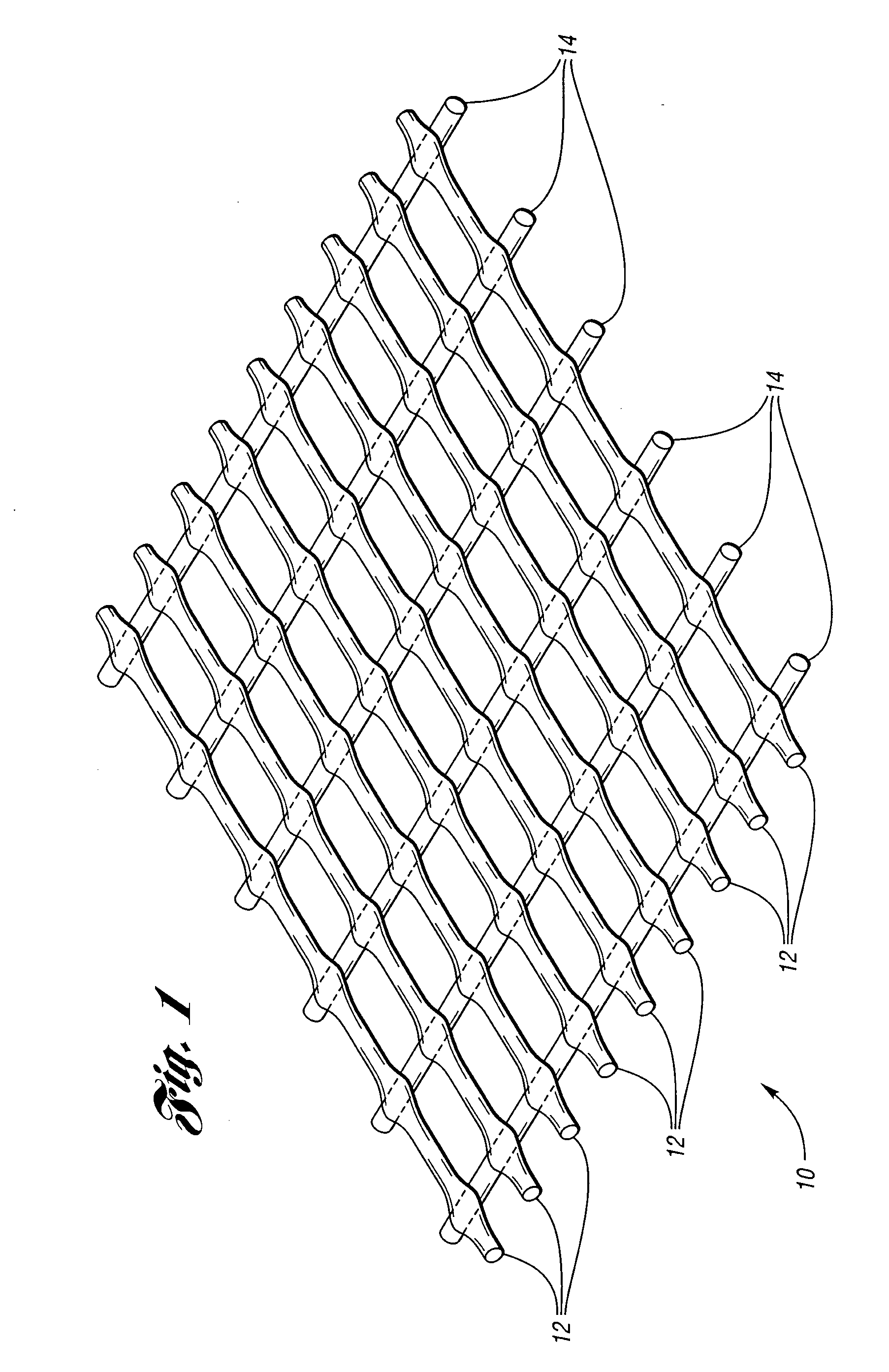Degradable netting
a technology of netting and netting parts, applied in the field of netting, can solve the problems of plastic material mechanical properties being reduced, plastic material completely being broken into smaller plastic particles, and increasing tensile strength and brittleness
- Summary
- Abstract
- Description
- Claims
- Application Information
AI Technical Summary
Benefits of technology
Problems solved by technology
Method used
Image
Examples
example 1
[0127] Various extruded nettings (stage 1) are extruded at a basis weight of 120 gsm (grams / m2). Various degradable compositions are used to form the nettings. The composition (wt. %) of the various nettings are set forth below in Table 1.
TABLE 1Weight ofCobaltCitricAminenettingCompositionPolyolefin1StearateAcid2Stabilizer3Colorant4(lbs. / 1000 ft2)A 99%000 1%1.45B97.87%0.7%0.23%01.2%1.45C 97.6%0.9% 0.3%01.2%1.45D98.14%0.5%0.16%01.2%1.45E97.94%0.5%0.16%0.2%1.2%1.45
1Atofina Polypropylene PPH 3060, available from Atofina of Brussles, Belgium.
2The cobalt stearate and citric acid are added in one component called Envirocare AG 1000C, available from Ciba Speciality Chemicals of Great Britain. Envirocare is believed to contain 50 to 80% polyethylene, 7.5 to 22.5% cobalt stearate, and 7.5 to 22.5% citric acid.
3Tinuvin ® 783 available from Ciba Speciality Chemicals of Great Britain. Tinuvin 783 is a 50:50 mixture of Ciba CHIMASSORB 944 and TINUVIN 622 with the following chemical names: ...
example 2
[0129] The nettings made of compositions A, B and C are then tested for aerobic degradation under controlled conditions at 40° C. for 1004 hours without exposure to any UV light (UVA—340 lamps) according to ASTM Test No. D4329-92.
[0130] The degradation rates of the nettings are determined in accordance with the following procedure. The net is initially tested for tensile strength in accordance with the Stage 2 netting tensile strength test, in the machine direction. The netting is then exposed to conditions that would bring on aerobic degradation in accordance with ASTM Test No. D4329-92 as set forth in Example 2. The net is then retested for tensile strength in accordance with the netting tensile strength test. The % difference in values is the % strength loss.
[0131] The results of the netting degradation are shown in Table 2 below.
TABLE 2Netting% Strength LossA 0%B21%C25%
[0132] The results of Table 2 show that without the degradation additives and UV light, the polypropylene n...
example 3
[0133] The nettings made of compositions A, B, C and D are then tested for aerobic degradation under controlled conditions at 30° C. for 285 hours with exposure to UV light (UVA—340 lamps) for 194 hours according to ASTM Test No. D4329-92. The degradation rate is determined in the same manner as in Example 2.
[0134] The results of the netting degradation are shown in Table 3 below.
TABLE 3Netting% Strength LossA11%B50%C40%D50%
[0135] The results of Table 3 shown that, under the exposure to heat and UV light, netting having the degradation additive will degrade greater (i.e., faster) than netting not having the degradation additive.
PUM
| Property | Measurement | Unit |
|---|---|---|
| density | aaaaa | aaaaa |
| wt. % | aaaaa | aaaaa |
| temperatures | aaaaa | aaaaa |
Abstract
Description
Claims
Application Information
 Login to View More
Login to View More - R&D
- Intellectual Property
- Life Sciences
- Materials
- Tech Scout
- Unparalleled Data Quality
- Higher Quality Content
- 60% Fewer Hallucinations
Browse by: Latest US Patents, China's latest patents, Technical Efficacy Thesaurus, Application Domain, Technology Topic, Popular Technical Reports.
© 2025 PatSnap. All rights reserved.Legal|Privacy policy|Modern Slavery Act Transparency Statement|Sitemap|About US| Contact US: help@patsnap.com


